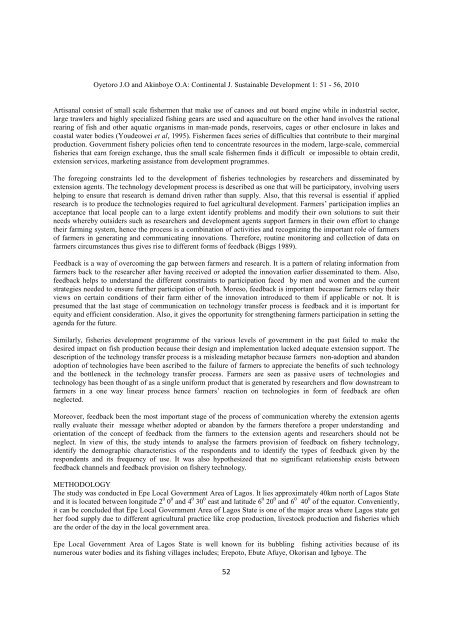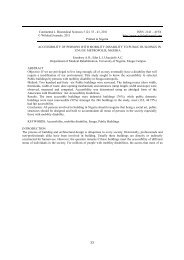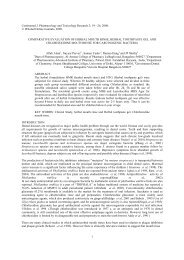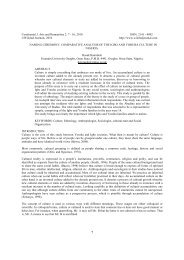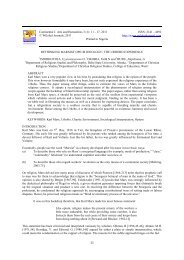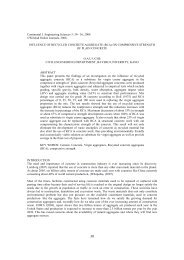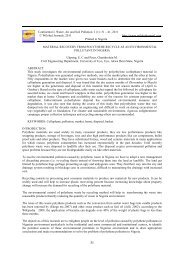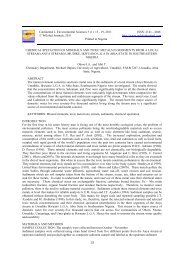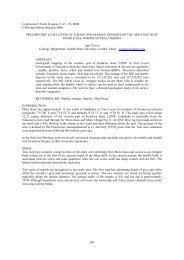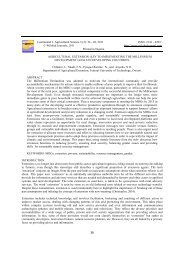Continental J. Sustainable Development 1 - Wilolud Journals
Continental J. Sustainable Development 1 - Wilolud Journals
Continental J. Sustainable Development 1 - Wilolud Journals
Create successful ePaper yourself
Turn your PDF publications into a flip-book with our unique Google optimized e-Paper software.
Oyetoro J.O and Akinboye O.A: <strong>Continental</strong> J. <strong>Sustainable</strong> <strong>Development</strong> 1: 51 - 56, 2010Artisanal consist of small scale fishermen that make use of canoes and out board engine while in industrial sector,large trawlers and highly specialized fishing gears are used and aquaculture on the other hand involves the rationalrearing of fish and other aquatic organisms in man-made ponds, reservoirs, cages or other enclosure in lakes andcoastal water bodies (Youdeowei et al, 1995). Fishermen faces series of difficulties that contribute to their marginalproduction. Government fishery policies often tend to concentrate resources in the modern, large-scale, commercialfisheries that earn foreign exchange, thus the small scale fishermen finds it difficult or impossible to obtain credit,extension services, marketing assistance from development programmes.The foregoing constraints led to the development of fisheries technologies by researchers and disseminated byextension agents. The technology development process is described as one that will be participatory, involving usershelping to ensure that research is demand driven rather than supply. Also, that this reversal is essential if appliedresearch is to produce the technologies required to fuel agricultural development. Farmers’ participation implies anacceptance that local people can to a large extent identify problems and modify their own solutions to suit theirneeds whereby outsiders such as researchers and development agents support farmers in their own effort to changetheir farming system, hence the process is a combination of activities and recognizing the important role of farmersof farmers in generating and communicating innovations. Therefore, routine monitoring and collection of data onfarmers circumstances thus gives rise to different forms of feedback (Biggs 1989).Feedback is a way of overcoming the gap between farmers and research. It is a pattern of relating information fromfarmers back to the researcher after having received or adopted the innovation earlier disseminated to them. Also,feedback helps to understand the different constraints to participation faced by men and women and the currentstrategies needed to ensure further participation of both. Moreso, feedback is important because farmers relay theirviews on certain conditions of their farm either of the innovation introduced to them if applicable or not. It ispresumed that the last stage of communication on technology transfer process is feedback and it is important forequity and efficient consideration. Also, it gives the opportunity for strengthening farmers participation in setting theagenda for the future.Similarly, fisheries development programme of the various levels of government in the past failed to make thedesired impact on fish production because their design and implementation lacked adequate extension support. Thedescription of the technology transfer process is a misleading metaphor because farmers non-adoption and abandonadoption of technologies have been ascribed to the failure of farmers to appreciate the benefits of such technologyand the bottleneck in the technology transfer process. Farmers are seen as passive users of technologies andtechnology has been thought of as a single uniform product that is generated by researchers and flow downstream tofarmers in a one way linear process hence farmers’ reaction on technologies in form of feedback are oftenneglected.Moreover, feedback been the most important stage of the process of communication whereby the extension agentsreally evaluate their message whether adopted or abandon by the farmers therefore a proper understanding andorientation of the concept of feedback from the farmers to the extension agents and researchers should not beneglect. In view of this, the study intends to analyse the farmers provision of feedback on fishery technology,identify the demographic characteristics of the respondents and to identify the types of feedback given by therespondents and its frequency of use. It was also hypothesized that no significant relationship exists betweenfeedback channels and feedback provision on fishery technology.METHODOLOGYThe study was conducted in Epe Local Government Area of Lagos. It lies approximately 40km north of Lagos Stateand it is located between longitude 2 0 0 0 and 4 0 30 0 east and latitude 6 0 20 0 and 6 0 40 0 of the equator. Conveniently,it can be concluded that Epe Local Government Area of Lagos State is one of the major areas where Lagos state gether food supply due to different agricultural practice like crop production, livestock production and fisheries whichare the order of the day in the local government area.Epe Local Government Area of Lagos State is well known for its bubbling fishing activities because of itsnumerous water bodies and its fishing villages includes; Erepoto, Ebute Afuye, Okorisan and Igboye. The52


